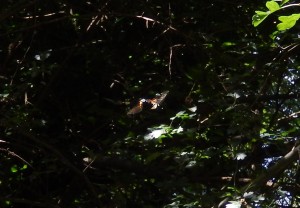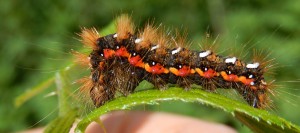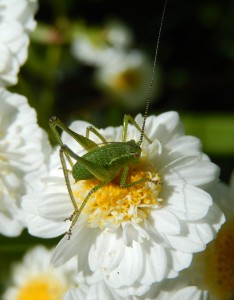
An English Summer is, as the saying goes, three fine days and a thunderstorm. Or, going out with sunhat, suncream, sunglasses… and a pullover and raincoat, just in case. Today it started out cold with a chill north-north-easterly wind, but quietened down and became rather too hot to work comfortably.
A tree had fallen across the glade in the Gunnersbury Triangle where the beekeeper is going to station one of her hives. I soon threw off my pullover, and my rainproof jacket never left my rucksack. The soft willow wood was no trouble to saw up, and I dragged the branches to the dead-hedge without much effort. A lot of small holm oak, an invasive alien species from the Mediterranean (think Ligurian coast) has sprung up from old stumps, so they joined the pile. A Blackcap sang to me while I worked.
The butterfly transect revealed very little, though some Commas are encouragingly laying eggs. As for other insects, several species of hoverfly, from tiny and slender to large wasp mimics and a fine one largely black, perhaps a bee mimic, were active. They hover, perch and sunbathe, or dash and chase each other (specially the large black ones) aggressively. I had fun trying to photograph one actually in the air, you can see the atmospheric but not very useful result above. It does give something of an idea how much they whiz and dash about, hovering always on the qui vive.
Ragwort is getting more and more abundant on the reserve; today, Helen spotted some tiny (probably first instar) Cinnabar Moth caterpillars on one of the plants; an adult visited me while I worked.
The Peacock Butterfly caterpillars of last week seem all to have pupated in hiding somewhere; there are quite a few younger ones still on the stinging nettles, so there will be at least two lots of adults.

We found a Knot Grass moth caterpillar (a Noctuid moth) on a bramble. It is hairy and aposematic, with brown hair but without the four long brown ‘shaving brush’ tufts of the Vapourer moth caterpillar (a Lymantriid or Tussock moth), which we’ve also found here.
But perhaps the insect I was happiest to see was this young Bush Cricket, resting on a flower for no particular reason, and taking a risk as its fine spotted green camouflage was totally compromised by its white and yellow flowery background. It must be the first one I’ve seen this year.

I have always loved natural patterns. The bark of this Aspen tree looks almost as if it encodes symbols in some cuneiform notation.

